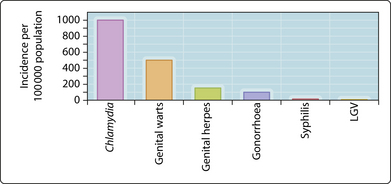25. Genital tract infections
Host susceptibility and epidemiology
Genital tract infections includes a number of sexually transmitted diseases (STDs), as well as some infections that do not require sexual activity for transmission. The STDs where the main symptoms occur outside the genital tract (e.g. HIV and hepatitis B) are considered elsewhere. In the male, with the exception of the distal 2–3 cm, the normal urethra is sterile, protected by mucus, prostatic secretions and periodic flushing with urine. The commensal flora of the vagina offers some protective effect, as does the mucus within the cervix and uterine cell turnover through menstruation. STDs require intimate contact for transmission. Contact tracing is undertaken following diagnosis to reduce transmission within the community; GPs will often refer patients to the local genitourinary clinic where all the facilities are available. Chlamydial and human papillomavirus infections are highly endemic among 16–24 year olds (Fig. 3.25.1)
The clinical syndromes
There are few clinical presentations: skin infections present in both sexes in the same way, whereas other genital infections manifest in different organs depending on gender (Fig. 3.25.2). Table 3.25.1 gives the methods of diagnosis and treatments.
< div class='tao-gold-member'>
Stay updated, free articles. Join our Telegram channel

Full access? Get Clinical Tree












